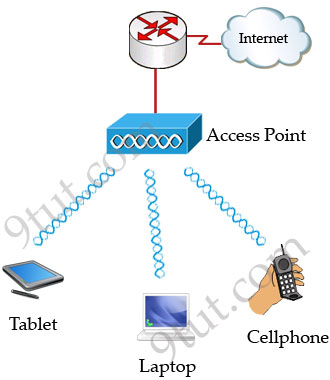Wireless Tutorial
In this article we will discuss about Wireless technologies mentioned in CCNA.
Wireless LAN (WLAN) is very popular nowadays. Maybe you have ever used some wireless applications on your laptop or cellphone. Wireless LANs enable users to communicate without the need of cable. Below is an example of a simple WLAN:

Each WLAN network needs a wireless Access Point (AP) to transmit and receive data from users. Unlike a wired network which operates at full-duplex (send and receive at the same time), a wireless network operates at half-duplex so sometimes an AP is referred as a Wireless Hub.
The major difference between wired LAN and WLAN is WLAN transmits data by radiating energy waves, called radio waves, instead of transmitting electrical signals over a cable.
Also, WLAN uses CSMA/CA (Carrier Sense Multiple Access with Collision Avoidance) instead of CSMA/CD for media access. WLAN can’t use CSMA/CD as a sending device can’t transmit and receive data at the same time. CSMA/CA operates as follows:
+ Listen to ensure the media is free. If it is free, set a random time before sending data
+ When the random time has passed, listen again. If the media is free, send the data. If not, set another random time again
+ Wait for an acknowledgment that data has been sent successfully
+ If no acknowledgment is received, resend the data
IEEE 802.11 standards:
Nowadays there are three organizations influencing WLAN standards. They are:
+ ITU-R: is responsible for allocation of the RF bands
+ IEEE: specifies how RF is modulated to transfer data
+ Wi-Fi Alliance: improves the interoperability of wireless products among vendors
But the most popular type of wireless LAN today is based on the IEEE 802.11 standard, which is known informally as Wi-Fi.
* 802.11a: operates in the 5.7 GHz ISM band. Maximum transmission speed is 54Mbps and approximate wireless range is 25-75 feet indoors.
* 802.11b: operates in the 2.4 GHz ISM band. Maximum transmission speed is 11Mbps and approximate wireless range is 100-200 feet indoors.
* 802/11g: operates in the 2.4 GHz ISM band. Maximum transmission speed is 54Mbps and approximate wireless range is 100-200 feet indoors.
ISM Band: The ISM (Industrial, Scientific and Medical) band, which is controlled by the FCC in the US, generally requires licensing for various spectrum use. To accommodate wireless LAN’s, the FCC has set aside bandwidth for unlicensed use including the 2.4Ghz spectrum where many WLAN products operate.
Wi-Fi: stands for Wireless Fidelity and is used to define any of the IEEE 802.11 wireless standards. The term Wi-Fi was created by the Wireless Ethernet Compatibility Alliance (WECA). Products certified as Wi-Fi compliant are interoperable with each other even if they are made by different manufacturers.
Access points can support several or all of the three most popular IEEE WLAN standards including 802.11a, 802.11b and 802.11g.
WLAN Modes:
WLAN has two basic modes of operation:
* Ad-hoc mode: In this mode devices send data directly to each other without an AP.

* Infrastructure mode: Connect to a wired LAN, supports two modes (service sets):
+ Basic Service Set (BSS): uses only a single AP to create a WLAN
+ Extended Service Set (ESS): uses more than one AP to create a WLAN, allows roaming in a larger area than a single AP. Usually there is an overlapped area between two APs to support roaming. The overlapped area should be more than 10% (from 10% to 15%) to allow users moving between two APs without losing their connections (called roaming). The two adjacent APs should use non-overlapping channels to avoid interference. The most popular non-overlapping channels are channels 1, 6 and 11 (will be explained later).

Roaming: The ability to use a wireless device and be able to move from one access point’s range to another without losing the connection.
When configuring ESS, each of the APs should be configured with the same Service Set Identifier (SSID) to support roaming function. SSID is the unique name shared among all devices on the same wireless network. In public places, SSID is set on the AP and broadcasts to all the wireless devices in range. SSIDs are case sensitive text strings and have a maximum length of 32 characters. SSID is also the minimum requirement for a WLAN to operate. In most Linksys APs (a product of Cisco), the default SSID is “linksys”.
In the next part we will discuss about Wireless Encoding, popular Wireless Security Standard and some sources of wireless interference.



thanx guys for the info but to those who need more shud Todd Lammle book 6th edition, has all the detail
hie
Pliz can some1 tell me if teleworkers are now in the ccna syllabus will be writing August monthed
9tut, A-W-E-S-O-M-E! Realy great. ;D
Thx so much.
Thanks for the info really usefull… Blessings!
thankzzzz for the information of wirless network
Can any1 send me , (danielagboh@yahoo.com) latest dump on 640-802. I wnt 2 write the exam in 2 weeks time.
@ 9tut
please upload tutorial on subnetting & vlsm
@9tut, pls upload 802.11n explanation.Thanks for about WLAN.
@darwin
hey, you can read everything you need about 802.11n here:
http://www.en.wikipedia.org/wiki/IEEE_802.11n-2009
good morning
@xallax…Thanks a lot for ur prompt reply.
what is initialization vector???
Hi, all .
When i config roaming , would I config more AP same SSID ?
@leethao
yes, but use different broadcast channel frequency numbers
nice explaination
Legeds live’s for ever!!!!
i need whole WAN tutorial please help me by sending email to arsadh007@yahoo.com
Hi,
I think there is a mistake here :
+ Listen to ensure the media is free. If it is free, set a random time before sending data
It should be : if it is NOT free, set a random time before sending data.
Thank you for this great website.
@CiscoMan: It is not a mistake, if the environment is free, it still waits a random time before sending data.
@CiscoMan: this further reduces the statistical probability of a collision. Silent -> random wait -> send
i am spellbound…what a precise , easy to understand tutorial…its simply too good:) 9tut…u rock!
dear sir
can i add the manual ip address in ad-hoc peer to peer connection
i think ad-hoc cannection supports nine wi-fi devices
Thanks! Its is a good stuff of wireless networking.
Hi 9tut.. in the explanation of 802.11 why don’t u add 802.11n? I need to know it’s difference than the other ones?
Thank You
I confused OFDM and searched it..found out that you forget to right Frequency.. u just write like this Orthogonal Division Multiplexing (OFDM)..
Thank You
same here.. im looking wheres F heh
nice explanation………..thanks a lot………….
Q6. 172.25.0.0 given. No mask or prefix given. 172 is a class be address with a classful mask of 255.255.0.0 prefix /16. This is only one subnet with range of 172.25.0.0 to 172.25.255.255 /16. We want eight subnets. 2 to the number of host bits borrowed equals the number of subnets gained. So we want 8 subnets. Borrow 3 hosts bit because 2^3 host bits borrowed equals 8 subnets gained from one subnet given. So borrowing 3 hosts bits, we move our classful /16 boundary 3 places to the right which would give us a new /19 prefix. There are 8 subnets gained and we want to know only what the 3rd subnet is and we have a ip subnet zero command configured which means that the first subnet is 172.25.0.0 to 172.25.31.255. The next subnet is 172.25.32.0 to 172.25.32.255. the third subnet is 172.25.64.0 to 172.95.255. Look at the ip address choices in the question and choose those that fit into the third subnet’s range. I hope this helps.
Sorry I made one mistake on Q6. the second subnet range is from 172.25.32.0 to 172.25.63.255.
gr8
@9tut
Now,as i understand from your words
roaming : must have same ssid but both AP must be on different frequencies
so my question is if both AP were on different frequencies so how can roaming happen ?
and if we used different frequencies like 1,6,11 …..so there is no overlapping and there is no roaming ? so why different frequencies
thanks
@jhon: They are in different frequencies. The device must get all necessary information about that AP, including frequency before “jumping” to another AP.
Thx so much.
Hello everybody!!!! Anyone that tell me, where download a study guide of CCNA_Wirless, please…
So, I’m passed CCNA 881 !!! last April 5th, 2013. If anyone need something else, and I help please send me a mail jcgt_83@hotmail.com
Thank you guys…See you soon
Hi 9tut if you have practice material of WAN like your EIGRP it is very educative with packet tracer. I want to practice WLAN in packet tracer but i have no idea how to practice WLAN with packet tracer, if you have some material kindly update.
dilsheramritsar@gmail.com
Thank you……
thanks a bunch!! this helped alot
G R E A T !!
Take a look at this site for a pdf tutorial – I am reading it over the next few days.
http://www.veriwave.com/pdf/07/80211_tutorial.pdf
Awesome lts easy but very comprehensive …….
where is the sec. parts of this tutorial?
Hello, I am writing in an unusual case … Some time ago, I used your services, and one of your employees face was familiar to me. At dinner with my wife, it turned out that he was a burglar, who 5 years ago broke into our home!!! This is ridiculous!!! How you can hire criminals? I found at least 3 bad entries for him at website for background check http://everifies.com !! I am sure there are more!!! Please do something about it, things like that are ridiculous!!!
hey,can I also get the vlsm tutorials on gmail
gachangocmbugua@gmail.com
I’ll appreciate.
Hey 9tut can you give me a server explaining web site.like this :)
Thank You
i never knew anything about networking. but your teachings have come with me this far. thanks very……………………….. much
thanks, for greater information about wlan
am a new student of wlan can some 1 mentol me oluwafemimichael206@yahoo.com and introduce me to any tutoria please
If it is free, set a random time before sending data
Should that read :
If it is NOT free, set a random time before sending data?
Please disregard previous comment – read respond to CiscoMan’s comment
Awesome